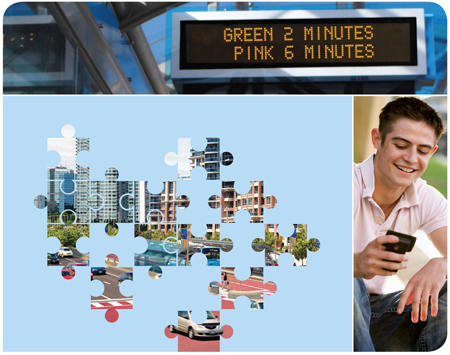In other posts I’ve talked about the various ITS components behind our Bus Rapid Transit along Highway 7. But none of these pieces would be able to do its job without being connected to the others through a sophisticated fibre optics communications system. Although it’s hiding underground, this communications system is really the unsung hero that’s going to put the rapid in our rapid transit system. Here’s how it’s going to work.
As I’ve described before, there are several transit priority measures that will help viva vehicles on the new Highway 7 rapidways run smoothly and quickly through congestion. These include on-board components on each vehicle including a GPS system and transmitters. There are also the components at each intersection that help each traffic signal respond to changing traffic requirements including radio and infrared receivers that pick up signals from approaching buses and emergency vehicles, and loop detectors in the roadway that detect cars waiting at the intersection. Lastly, there are the variable message signs (VMS) located at each platform that provide next-bus arrival information to customers.
As high-tech as each of these components is, none can be effective unless it can communicate with the others. Each one also needs to be connected to the overall transit system which keeps track of the schedule for each bus, and which determines when the traffic signal phasing requires a temporary adjustment to let a delayed bus get back on schedule.
The connection is provided through a fibre optics communications network that links all of the intersection and every vivastation to YRT’s transit operations and York Region’s traffic operations.
This system is fully automated, with approaching vehicles alerting intersections that they are arriving, and each intersection sharing that information with the central traffic control system, which in turn compares that information with the transit schedule. The system will continuously adjust and fine-tune to ensure the buses stay on schedule, while keeping the roads and intersections working well for everyone.
To enhance passenger safety, each station is equipped with cameras to monitor the platforms, a public address system to provide announcements and an emergency call box for personal safety. All of these systems operate reliably and seamlessly over the fibre optic communications system.
By using fibre optics technology running the entire length of the corridor, we’ll be able to collect all this information and transmit it quickly so that the transit system can respond immediately. The communication system will also provide the real-time bus arrival information displayed on station VMS.
With this high-tech communications system providing the brains to the transit system, viva will make it easier, faster and more reliable to travel across York Region. Check out this video on how this system works.

